

By
Don and Linda Freedman
Search
TheTravelzine
TheTravelzine Group
Access Your Mail
Don's
Gallery
Packing
Hints
Planning
Tips
Cities
Links
Links
LINKS TO OUR TRAVELOGUES
Argentina, Buenos Aires - Jan-Mar 2010
Argentina, Buenos Aires - Jan-Mar 2009
Argentina, Buenos Aires - Jan-Mar 2008
Austria - Fall 2005
Belgium, Brussels - Fall 2000
Canada - Summer 2002
Canada - Summer 2001
Canada - Summer 2000
Czech Republic - Spring 2000
France - Fall 2002
France, Paris - Fall 2000
France, Paris - Spring 1999
France, Lyon - Spring 1999
Germany, Berlin - Fall 2009
Germany - Fall 2002
Germany - Spring 2000
Germany - Fall 1999
Greece - Fall 2012
Greece - Fall 1999
Greece - Fall 1997
Hungary - Spring 2000
Israel - Fall 1999
Italy - Winter 2007
Italy - Winter 2006
Italy - Winter 2005
Italy - Winter 2004
Italy - Winter 2003
Italy - Winter 2001
Italy - Fall 1998
Italy - Fall 1996
Netherlands - Spring 2000
Portugal, Azores - 2019
Portugal, Azores - 2018
Portugal, Sao Miguel & Lisbon - 2017
Portugal, Azores - 2017
Portugal, Azores - 2016
Portugal, Azores - 2015
Portugal, Azores - 2014
Portugal, Azores - 2013
Portugal, Azores - 2012
Portugal, Azores - 2011
Portugal, Lisbon - 2011
Portugal - Fall 2006
Portugal - Fall 2004
Portugal - Fall 2003
Portugal - Fall 2001
Portugal - Spring 1999
Portugal - Spring 1997
Slovakia - Spring 2000
Slovenia - Spring 1999
Slovenia - Fall 1996
Spain, Barcelona - Winter 2006
Switzerland - Fall 2002
Switzerland - Spring 2000
Switzerland - Spring 1999
Switzerland - Fall 1998
Switzerland - Fall 1997
Switzerland - Spring 1996
U.S. Florida, Key West - Fall 2006
U.S. Florida - Spring 2001
U.S. Maine - Summer 2002
U.S. Massachusetts - Summer 2003
U.S. Massachusetts - Summer 2002
U.S. Massachusetts - Summer 2001
U.S. New York State - Fall 2005
U.S. New York State - Summer 2004
U.S. New York State - Summer 2003
U.S. New York State - Summer 2001
U.S. Washington,DC - Spring 2000
AUSTRIA
FALL 2005
Wachau_Krems_Melk_Durnstein
Salzburg | Kufstein_Kitzbuehel
Rattenberg_Hall | Innsbruck
Zell Am See_Kaprun | Spittal
Klagenfurt | Graz | Vienna
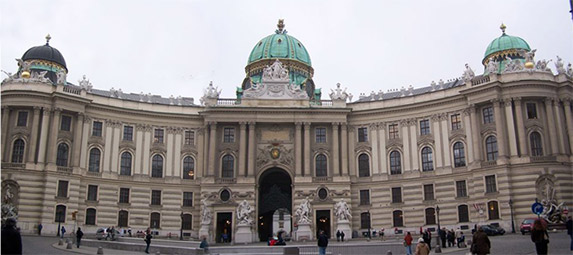
The old city center of Vienna, is encircled by the handsome Ringstrasse. Emperor Franz Joseph I had the city walls demolished in 1857 and in their place built this boulevard lined with the exquisite buildings that help make Vienna the gorgeous city it is.
We stayed just south of the Ring for two nights and in the center for one night. Our train from Graz arrived at the Sudbahnhof mid-afternoon from which we took the "D" tram to Karlsplatz, the intersection of Kartnerstrasse and Kartner Ring. We disembarked and were greeted by the grand Vienna State Opera, a reminder that the most famous composers in the world have lived and worked here. Not only Wolfgang Amadeus Mozart, whose yearlong 250th birthday celebration starts here on January 27, 2006 but Johann Strauss, Franz Schubert, Ludwig Van Beethoven and Joseph Haydn.
We walked south on Kartnerstrasse (north would have taken us along the wide shopping boulevard of Kartnerstrasse directly to St. Stephansplatz, the center of the old city), which becomes Wiedner Hauptstrasse, to Frankenbergasse 10 and the Hotel Kaiserhof. Since 1896 eight generations of the same family have operated this splendid old house. Over time it has maintained its grandeur while adding contemporary design elements. Enter the dazzling yellow and white lobby capped by a sculpted, high ceiling to a warm welcome. A cozy seating area leads to a very inviting, contemporary library lounge with bar.
The yellow and white theme of the
public areas carried through to our spacious king room
with fine quality, well chosen furniture, furnishings and
bedding. On the counter top of the lovely tiled bathroom
was a basket filled with excellent hair and body care
products and a few extras goodies. It would be a very
comfortable two nights as were the mornings in the lovely
breakfast room with a very good buffet and service.
The Kaiserhof is located in the 4th district in Freihausviertel. Once a poor neighborhood where the city provided free housing (Freihaus) it has evolved into a desirable place to live and work because it is close to the city center and is still affordable. Streets like Operngasse, Muhlgasse, and Schleifmuhlgasse are filled with trendy and traditional art galleries, home furnishings shops, fashion boutiques, eateries, cafes and food shops. Some of the local favorites that looked pretty good to us where: "The Point of Sale" a coffee shop, "The Breakfast Club" for breakfast and lunch, "Rauminhalt" modern furniture, "Grand Cacao" outrageous chocolates, "Babette's" cookbooks, "Restaurant Muhlbach" trendy restaurant-bar-cafe, "Cafe Anzengruber" traditional, "Altwien" house-roasted coffee, etc. We strolled the streets into the early evening as folks returned from work and began filling up the bars, cafes and restaurants. Freihausviertel is young, fun and full of energy. If you don't move here, visit!
The public transportation system is superb with efficient and clean underground, bus and tram service. The 72 hour Vienna Card for 16.90 euro covers it all plus other free entrances and discounts. It's a real bargain.
With Vienna Card in hand we zipped over to Burggasse 63 to Restaurant Zu den 2 Lieserln which a friend had recommended. It's small with paneled walls, decorated with a few artifacts. The specialty here is schnitzel. We started with delicious Ottakringer beer and very good Viennese soup (beef broth with pieces of meat, vegetables, noodles and herbs) served hot and hearty. We had the small size (more than enough, even for me!) schnitzel, a thick slice of tender pork lightly battered and fried to a crisp doneness, which was served with a large portion of delectable potato salad. Cost was very reasonable; exceptional value here!
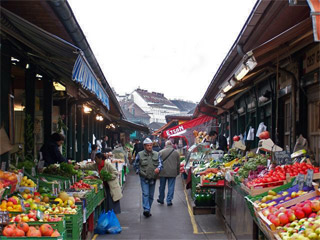 A short walk after breakfast and we arrived
at the Naschmarkt, uniquely located between the banks (Wienzeile
Linke, left and Wienzeile Rechte, right) of the Wien
river, roofed during the nineteenth century. The
Naschmarkt, a Viennese institution, is the largest market
with a middle eastern influence. Neat stalls sell
everything from foods to clothing to household products
and there are many cafes, bars and restaurants for a
lunch break. Following the demographics of the
surrounding area, there seems to be a movement to a bit
more upscale and trendy direction for the eating and
drinking establishments. For added shopping fun there is
a Saturday morning flea market. The offerings were
enticing but after our bountiful breakfast, we were able
to move on without indulging.
A short walk after breakfast and we arrived
at the Naschmarkt, uniquely located between the banks (Wienzeile
Linke, left and Wienzeile Rechte, right) of the Wien
river, roofed during the nineteenth century. The
Naschmarkt, a Viennese institution, is the largest market
with a middle eastern influence. Neat stalls sell
everything from foods to clothing to household products
and there are many cafes, bars and restaurants for a
lunch break. Following the demographics of the
surrounding area, there seems to be a movement to a bit
more upscale and trendy direction for the eating and
drinking establishments. For added shopping fun there is
a Saturday morning flea market. The offerings were
enticing but after our bountiful breakfast, we were able
to move on without indulging.
We passed Cafe Sperl, one of Vienna's oldest and most famous, and again we were tempted, but there was no sense stopping unless we were prepared to do the Cafe thing, sit for a while sip a coffee and slowly enjoy a sweet, which we were not.
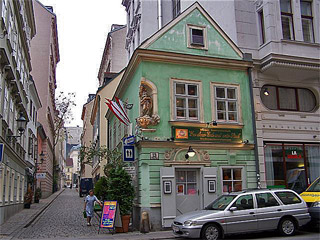 Konigsklostergasse brought us to Karl
Schweighofergasse and to the five streets between
Siebensterngasse and Burgasse that make up the very
popular Spittelberg Quarter. After restoration and
revitalization of the Baroque buildings, the area is
vibrant with colorful narrow streets, randomly linked by
alleyways and passageways, a maze of interesting cafes,
bars, restaurants and shops neatly integrated with the
fine homes.
Konigsklostergasse brought us to Karl
Schweighofergasse and to the five streets between
Siebensterngasse and Burgasse that make up the very
popular Spittelberg Quarter. After restoration and
revitalization of the Baroque buildings, the area is
vibrant with colorful narrow streets, randomly linked by
alleyways and passageways, a maze of interesting cafes,
bars, restaurants and shops neatly integrated with the
fine homes.
[Back
to Top]
Spittelberg is a neighbor of the MuseumsQuartier Wien, a huge cultural complex dedicated to modern and contemporary art and culture. Originally the Imperial Stables, it became a venue for trade fairs and exhibits and in 2001 was inaugurated as the MuseumsQuartier. The historic buildings were restored and integrated with new contemporary designs creating a spectacular oasis of art, culture, fun and relaxation on a site in the city between the historic Vienna Hofburg Palace, Imperial residence & Palace of art, and the evolving contemporary neighborhoods. It's a brilliant blending of the old and new.
This is one of the ten largest
cultural complexes in the world with venues for fine and
performing arts, music, fashion, theater, architecture,
new media and children's culture. The most recent
buildings best identify the character of today’s
MuseumsQuartier. 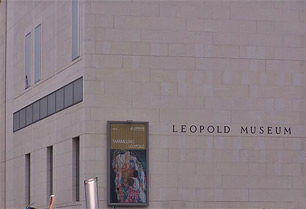
The white limestone Leopold Museum displays the world's largest Schiele collection plus works by Kokoschka, Gerstl, Kubin and others.
The Museum of Modern Art Ludwig Foundation of Vienna, a beauty of dark basalt lava, documents the important artistic trends of the twentieth century.
The brick new Kunsthalle Wien emphasizes the avant-garde, with changing exhibitions and developments on the international art scene.
The Architecture Center Vienna presents exciting contemporary exhibits and in its permanent exhibition features Austrian architecture of the twentieth and twenty-first centuries. Children are treated to creative experiences at the Zoom Childrens Museum and the Dischungel Wien, Theater House for a young audience. Quartier 21 offers space for the presentations and creations of cultural exhibitors, Halls E and G are used for festivals and modern body art of all kinds can be seen at the Tanzquartier Wien.
There is an Artist-in-Residence Program that fosters international, project-related exchange financed with the aid of private sponsors. Each year about forty artists from other countries are invited to work on location on joint projects with the resident cultural initiatives.
Standing in the enormous lively
inner courtyard surrounded by this spectacular marriage
of tradition and modern, it was easy to understand why
the MuseumsQuartier and its environs has become such a
popular destination.
[Back
to Top]
When you have satiated your art and culture needs, you can spend hours strolling Mariahilferstrasse, the fabulous mile-long shopping street that starts at the MuseumsQuartier, or take a break at one of the strategically located, beautifully designed cafes, bars or restaurants.
At Museumplatz, across the way toward the city center, wonderful Hapsburg buildings house the Kunsthistorisches Museum and the Naturhistorisches Museum. The former contains the largest Bruegel collection in the world plus works of other great masters including Raphael, Rembrandt and Rubens, and the Hapsburg’s significant collections of sculpture and decorative arts from Greek, Roman, Egyptian and Near Eastern antiquities. The Museum of Natural History houses treasures from pre-historic to endangered and extinct species.
We continued on to Heldenplatz and the magnificent, architecturally exquisite, Hofburg Wein. The Imperial Palace, formerly the center of the vast empire of the Hapsburg dynasty, now houses the offices of the Austrian President and a host of attractions including cafes, restaurants and gardens. There is much to experience here: the Vienna Boys Choir sings mass at the Chapel on Sundays, the Lipizzaner stallions perform at the Spanish Riding School, the private rooms of the Empress Sisi in the Imperial apartments can be visited, as well as more than twenty-four museums.
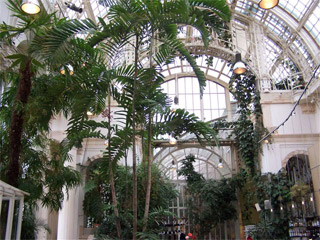 We headed directly
to the greenhouse complex of the gardens because we had a
tip that there was a new restaurant with very good food
in that unique setting. A section of the old greenhouse
has been turned into a bright, airy, glorious dining
experience. The high, intricately-designed glass roof and
windows allows the sunshine to stream in for the trees,
vines and plants that grace the open space. The fresh,
contemporary design includes a long bar with comfy stools
and an open kitchen featuring fresh fish. We decided on
salads of beets, fresh grilled tuna and greens from the
daily menu and saved our calorie intake for the
outrageous desserts we would indulge in later in the
afternoon.
We headed directly
to the greenhouse complex of the gardens because we had a
tip that there was a new restaurant with very good food
in that unique setting. A section of the old greenhouse
has been turned into a bright, airy, glorious dining
experience. The high, intricately-designed glass roof and
windows allows the sunshine to stream in for the trees,
vines and plants that grace the open space. The fresh,
contemporary design includes a long bar with comfy stools
and an open kitchen featuring fresh fish. We decided on
salads of beets, fresh grilled tuna and greens from the
daily menu and saved our calorie intake for the
outrageous desserts we would indulge in later in the
afternoon.
[Back
to Top]
Walking on Kohlmarkt, one of the city centers’ premier shopping ways, we stopped in our tracks at #14 in front of Demel, our dessert dream come true. The ancient wood counters and cases display a marvelous selection of pastries and candies. We wandered through rooms of Viennese charm and found a table at the rear near an open kitchen where the chefs performed their magic. After settling in, we returned to the front to make our selections and received a ticket with a number to give to our waitress. Choosing was very difficult because everything looked so wonderful. I had a soft doughy bun filled with fresh plums in an awesome vanilla sauce and Linda a three-layer torte of apples, poppy seeds and plums, and a large side of "the best yet" schlag. The coffee, of course, was excellent. By the way, Demel also offers a contemporary food menu.
At the end of Kohlmarkt at Am Graben 19 is Julius Meinl am Graben, one of the finest gourmet food emporiums we have encountered. Starting life in 1862 roasting green coffee beans on the family kitchen stove, it evolved into a retail food empire which was lost after the outbreak of WWII. In 1996 Meinl returned to its roots as a leading supplier of coffees, teas, jams and other fine foods. This posh culinary epicenter was opened in 2000 with three floors of magnificently presented food products from around the world. There is an elegant restaurant on the first floor and a separate seafood bar with stools and stand-up tables. For something lighter there's a ground floor cafe and prepared foods counter. It was a sensual treat just being there.
We walked through town back to our hotel for a brief rest before strolling over to Restaurant Waldviertlerhof, Schonbrunnerstrasse 20, for a marvelous traditional Viennese experience. There are many rooms and every one was packed, many with large parties. Busy as it was, our waiter was attentive and helpful. We had sturm for the first time this trip and regretted having waited so long to indulge. (Sturm is delicious, semi-fermented grape juice from the first grape harvest of the season.) Linda had knoedln scrambled with egg, onions and herbs with a mixed salad and I, young deer in a luscious mushroom sauce, a soft and tasty knoedl (that put all others to shame), and cranberry sauce. Perfect from every aspect, including the reasonable prices, Waldviertlerhof is excellent value.
Today was moving day. We took the underground to St. Stephansplatz, the heart of the old center walked past St. Stephen’s cathedral for a short distance on Schulerstrasse to #14, Hotel Domizil, a fabulous city center location. This is a cozy charmer with a friendly, caring staff. The lobby, with reception desk, has a small bar and complimentary internet point. A bountiful breakfast buffet is served in the adjacent pretty breakfast room.
Tall double doors opened to our room that exuded homey comfort with a king bed, desk, chairs and a small table. The nicely tiled bathroom with a tub and shower was stocked with the basic necessities. All the furnishings were well chosen and good quality.
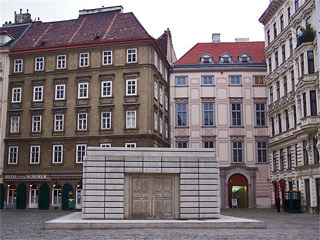 We made our way over to Judenplatz to the
New Museum Judenplatz, an annex of the Jewish Museum
Vienna, and the Memorial to the Austrian victims of the
Shoah. The idea of the memorial was conceived by Simon
Wiesenthal and realized in October 2000. Brilliantly
designed by the British sculptress Rachel Whiteread, it
has the form of a library turned inside out, the exterior
walls in the form of library shelves. Around the bottom
of the monument are engraved the names of 65,000 Austrian
Jews that were put to death during the Nazi regime. The
Memorial is linked to the Information Rooms on the Shoah
on the ground floor of the New Museum in the Misrachi
house, Judenplatz 8, whose contents have been provided by
the Documentation Archives of the Austrian Resistance.
The multimedia presentation consists of the names and
data of the 65,000 Jews together with the circumstances
that led to their persecution and death.
We made our way over to Judenplatz to the
New Museum Judenplatz, an annex of the Jewish Museum
Vienna, and the Memorial to the Austrian victims of the
Shoah. The idea of the memorial was conceived by Simon
Wiesenthal and realized in October 2000. Brilliantly
designed by the British sculptress Rachel Whiteread, it
has the form of a library turned inside out, the exterior
walls in the form of library shelves. Around the bottom
of the monument are engraved the names of 65,000 Austrian
Jews that were put to death during the Nazi regime. The
Memorial is linked to the Information Rooms on the Shoah
on the ground floor of the New Museum in the Misrachi
house, Judenplatz 8, whose contents have been provided by
the Documentation Archives of the Austrian Resistance.
The multimedia presentation consists of the names and
data of the 65,000 Jews together with the circumstances
that led to their persecution and death.
[Back
to Top]
The New Museum Judenplatz is made up of three permanent exhibition rooms depicting medieval Jewish life in Vienna and the excavations of the medieval synagogue, one of the largest in Europe, which was discovered in 1995 beneath Judenplatz. A multi-media presentation vividly portrays the religious, cultural, business and social life of the Viennese Jews of the Middle Ages until their expulsion and death in 1420/21 during the "First Vienna Gesera", as it is called. The late medieval synagogue was built around the middle of the 13th century and in the ensuing 150 years, it was enlarged to about 4320 sq.ft. After the pogrom in 1420/21 it was systematically destroyed so that only the foundations and floor remained. The archaeological exhibition room houses the remnants of the synagogue, which consisted of three rooms, before the last enlargement. A few surviving ceramic floor tiles are displayed.
The Jewish Museum Vienna, is housed in the Palais Eskeles, Dorotheergasse 11. Remembrance is the key to Jewish culture and it permeates the museum, which is a place of encounter, communication and discussion via symposiums, readings, concerts etc. The permanent exhibitions are supplemented by temporary exhibits on Jewish history, religion and culture.
The presentation of Max Berger Judaica collection, dating mostly from the Hapsburg monarchy, explains the function of ritual objects in the Jewish festivals and daily life.
New York artist Nancy Spero has
interpreted images and texts of the history of Vienna and
stamped them on the walls to provide a fresco-like
fragment of remembrance that complements the Judaica
collection. 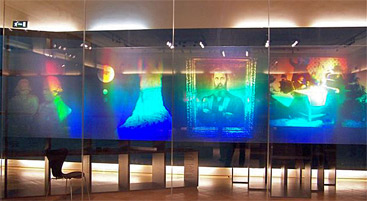
[Back
to Top]
An outstanding hologram presentation depicts the Jewish experience in Vienna from the middle ages to the present. It is an interesting interpretation of Vienna's Jewish history, three-dimensional, yet intangible, as the images appear and disappear as one moves through the gallery.
The viewable storage area displays the entire inventory of ritual objects that had been brutally removed from their accustomed places, the households, synagogues and prayer houses, in 1938. The museum archives provide fragmentary excerpts from Jewish life.
There was a marvelous temporary exhibit, "Mahleriana, the Making of an Icon", that ends January 8, 2006. This exhibition by the International Gustav Mahler Society documents the Society's commitment to the recognition of Mahler's music. The society has managed to salvage the three composing huts on the Attersee, Woerthersee and in South Tyrol, where Mahler composed his music, and has turned them into memorials to the artist. The significance of the composing huts is a central theme of the exhibition. There is an audio guide of Mahler’s music and comments by his family, friends and other musicians.
We found fabulous apple strudel at Cafe Diglas, Wollzeile 10. The food being served looked appetizing but we were here with other intentions. The plump strudel with crispy pastry was filled with apples, raisins and nuts and served at room temperature, my favorite way. The coffee was superb. Thank you, call again, member of the apple strudel club!
At the beginning of the 19th
century the Jewish community of Vienna received
permission to build a synagogue under the condition that
it would not be seen from the street. So it was that the
monumental Stadttempel synagogue was built on
Seitenstettengasse from 1824-26 and consecrated on April
9, 1826; Cantor Solomon Sulzer performed a musical
arrangement written by Franz Schubert. 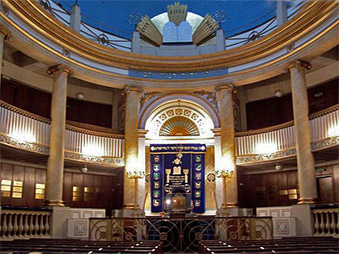
The Neo-Classical design was one of the most innovative in the city and became a model for other synagogues in western Europe. It became the first official Ashkenazi communal synagogue. Two five-storey elongated apartment buildings facing the street concealed the synagogue from view. The building was built in an oval shape with a large umbrella-like dome. Twelve Ionic columns, for the twelve tribes of Israel, support a two-tiered women's gallery. The ceiling was painted sky blue with golden stars. The Bimah was on the east side of the hall and opposite it stood the double level Holy Ark. On top are the Tablets of the Law within a golden sunburst. A memorial to the 65,000 Jews who were murdered has been erected in the foyer. Names are engraved on rotating slate tablets. Pieces are broken off the center granite column, symbolizing the destruction of the Jewish community in Vienna in 1938.
The interior was only slightly damaged during Kristallnacht. It was repaired in 1945 and rededicated in 1946, its 120th anniversary, with a public prayer in the presence of cabinet ministers. It was declared a historic site and is the central synagogue of the Jewish community of Vienna.
We must admit that it was a very
good job of concealment because if we did not bump into a
security official, we might still be looking for the
entrance.
[Back
to Top]
The same friend that recommended last evening’s restaurant also suggested Gasthaus Zu Den 3 Hacken, Singerstrasse 28, telephone 512-5895, the oldest tavern in Vienna, a few minutes walk from the Domizil. An enticing green patio leads into a warm neighborhood environment complete with a lovely waitress. Our Scwechater Hofenperie beer won the best beer award, delicious, especially with the yummy, doughy rye pretzel. The beef, vegetable and noodle soup, an old favorite, was excellent. Roast pork with sauerkraut and sautéed liver were both served with wonderful semolina dumplings. This was a splendid, very good value home-style Austrian meal for fond memories of our last dinner of the trip.
At Wien-Mitte Bahnhof it is possible to check luggage and get a boarding pass for many airlines from 24 hours to 75 minutes prior to departure. You have to use the CAT, city airport train to use this advance boarding pass/luggage check service. The CAT offers a discount with the Vienna card. A cheaper alternative from Wien-Mitte, is to take the "S" line #7 to the airport for 1.50 euro. The CAT takes about 8 minutes less than the "S" line to the airport.
After a substantial breakfast at Hotel Domizil, we wheeled our bags to St. Stephansplatz, took the U3 line to Wien-Mitte, transferred to the "S" line and took #7 to the airport.
I had my deer many ways and Linda
her share of schnitzel and all the strudel mit schlag we
could handle. The mountain air was fresh and the lakes
sparkling. The cities and towns were a wonderful world of
tradition, bursting with a new energy. Make plans to go -
be there to sing Happy Birthday to Mozart!
[Back
to Top]
Wachau_Krems_Melk_Durnstein
Salzburg | Kufstein_Kitzbuehel
Rattenberg_Hall | Innsbruck
Zell Am See_Kaprun | Spittal
Klagenfurt | Graz | Vienna
Search TheTravelzine | TheTravelzine Group | Don's Gallery
Packing Hints | Planning
Tips | Cities
Links
All pages on TheTravelzine.com©Copyright 1996-2020 Don & Linda Freedman